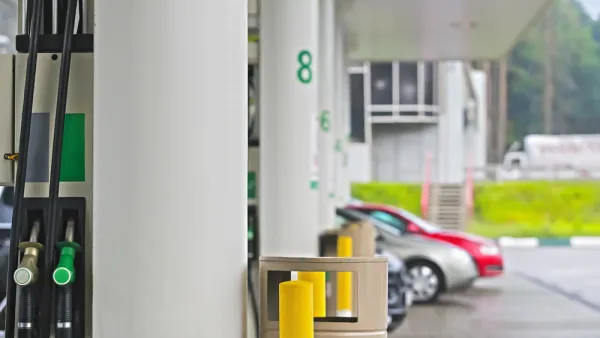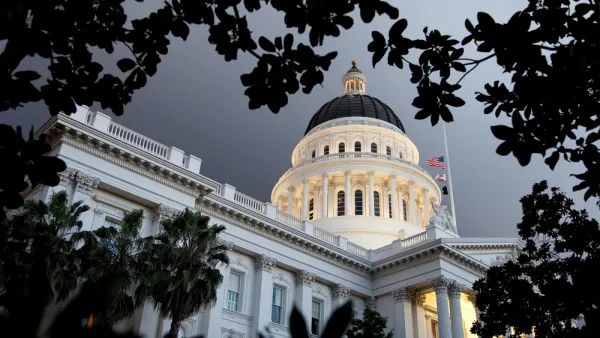Carl Davis, Research Director of the Institute on Tax and Economic Policy (ITEP) writes where gas taxes used to fund transportation infrastructure increased, if only by decimal points, and about the aberration—the six-cent plunge in California.
"The largest gas tax increases are taking place in Idaho (7 cents per gallon) and Georgia (6.7 cents for gas and 7.7 cents for diesel)," writes Davis. "Each of these increases is occurring due to legislation enacted earlier this year."

- Maryland's gas tax increase stem from 2013 legislation signed by then-Governor Martin O'Malley (now a presidential candidate).
- "Rhode Island’s 1 cent increase is the first automatic update for inflation to take place under a law signed by former Gov. Lincoln Chafee in 2014 (Chafee is now a presidential candidate as well)," writes Davis.
- Finally, Nebraska’s 0.5 cent hike and Vermont’s 0.35 cent increase are automatic changes resulting from these states’ variable-rate gas tax structures. Surprisingly, 19 states and the District of Columbia have this type of gas tax structure according to a February ITEP report.
On to the negative side of fuel tax changes that took effect July 1:
- California's six-cent tax decrease from 36 cents to 30 cents results from a vote of the state's Board of Equalization on Feb. 24 required by the 2010 gas tax swap legislation. Legislation has been introduced to change the formula to avoid the large spikes in increases or decreases required.to adjust the tax. SB 321 passed the Senate 40-0 on June 1 and is now in the Assembly. But it's not all negative as Davis notes that "a unique quirk in California’s law will cause the diesel tax to rise by 2 cents."
- Connecticut: "The diesel tax rate will drop by 4.2 cents as a result of laws linking gas tax rates to gas prices," writes Davis. "Earlier this year, similar automatic cuts had been scheduled to take place in Kentucky and North Carolina, but lawmakers in both of these states wisely intervened by placing a 'floor' on their gas tax rates that minimized the loss of infrastructure revenue," adds Davis.
Perhaps it's not correct to list those two states as gas tax increases as they in fact decreased - but they are included among the "seven states" in an earlier Planetizen post of 2015 state legislated gas tax increases nonetheless.
Additional notes on state gas taxes mentioned above:
- Don't confuse Nebraska's mandated half-cent gas tax increase with an upcoming gas tax increase of 1.5 cents on Jan. 1, 2016 that results from LB 610's passage on May 14 when the Senate overrode Gov. Pete Ricketts veto. It will be the first phase of a six-cent gas tax increase.
- In addition to SB 321 to adjust the formula used to make future gas tax changes to be voted on by the California Board of Equalization, Sen. Jim Beall has an additional bill to increase the excise tax by 10-cents, SB 16. Look for the bill under a new number, SB 1X, as it will be the topic of a special session on transportation called by Gov. Jerry Brown.
Finally, omitted above is:
- Alaska's .95 cent gas tax increase: It is not included as this post is based on the ITEP news blog. In an email, ITEP research director Carl Davis explained that only infrastructure-funding tax changes were included. The Alaska tax increase, as significant (or insignificant) it may be, will be used to fund oil spill prevention and response.
FULL STORY: Gas Tax Changes Take Effect July 1

National Parks Layoffs Will Cause Communities to Lose Billions
Thousands of essential park workers were laid off this week, just before the busy spring break season.

Retro-silient?: America’s First “Eco-burb,” The Woodlands Turns 50
A master-planned community north of Houston offers lessons on green infrastructure and resilient design, but falls short of its founder’s lofty affordability and walkability goals.

Delivering for America Plan Will Downgrade Mail Service in at Least 49.5 Percent of Zip Codes
Republican and Democrat lawmakers criticize the plan for its disproportionate negative impact on rural communities.

Test News Post 1
This is a summary

Test News Headline 46
Test for the image on the front page.

Balancing Bombs and Butterflies: How the National Guard Protects a Rare Species
The National Guard at Fort Indiantown Gap uses GIS technology and land management strategies to balance military training with conservation efforts, ensuring the survival of the rare eastern regal fritillary butterfly.
Urban Design for Planners 1: Software Tools
This six-course series explores essential urban design concepts using open source software and equips planners with the tools they need to participate fully in the urban design process.
Planning for Universal Design
Learn the tools for implementing Universal Design in planning regulations.
EMC Planning Group, Inc.
Planetizen
Planetizen
Mpact (formerly Rail~Volution)
Great Falls Development Authority, Inc.
HUDs Office of Policy Development and Research
NYU Wagner Graduate School of Public Service




























